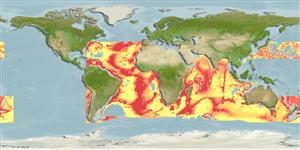>
Beryciformes (Sawbellies) >
Stephanoberycidae (Pricklefishes)
Etymology: Acanthochaenus: Greek, akantha = thorn + Greek, chaino = with the mouth opened (Ref. 45335).
Eponymy: Professor Christian Frederik Lütken (1827–1901) was a Danish naturalist, specialising in marine zoology. [...] (Ref. 128868), visit book page.
More on author: Gill.
Environment: milieu / climate zone / depth range / distribution range
Écologie
marin benthopélagique; profondeur 1655 - 5397 m (Ref. 58018). Deep-water; 40°N - 57°S, 77°W - 164°W
Atlantic, Indian and Pacific: in subtropical and temperate waters (Ref. 50895). In the Indian Ocean known localities include the Madagascar Ridge (Ref. 51654) and the West Australian Ridge, Naturalist Plateau.
Length at first maturity / Taille / Poids / Âge
Maturity: Lm ?, range 12 - ? cm
Max length : 15.2 cm TL mâle / non sexé; (Ref. 41039)
Épines dorsales (Total) : 0; Rayons mous dorsaux (Total) : 11; Épines anales: 1; Rayons mous anaux: 9 - 10. Body scales are spiny (Ref. 37108). Body elongated, almost cylindrical, somewhat compressed (Ref. 10920). The snout protrudes forward above upper jaw, its length 3.4-4.4 times in head length, eyes fairly small, upper jaw extends beyond the posterior border of the eye. Dorsal and anal fins are opposite one another (Ref. 10920).
Adults probably benthopelagic (Ref. 51654). Larvae taken at 30 m (Ref. 51654). Benthic crabs Malacostraca were found in the stomachs of 3 specimens SL 8.5-9 cm from Madagascar Ridge (Ref. 10920).
Life cycle and mating behavior
Maturité | Reproduction | Frai | Œufs | Fécondité | Larves
Maul, G.E., 1990. Stephanoberycidae. p. 611. In J.C. Quero, J.C. Hureau, C. Karrer, A. Post and L. Saldanha (eds.) Check-list of the fishes of the eastern tropical Atlantic (CLOFETA). JNICT, Lisbon; SEI, Paris; and UNESCO, Paris. Vol. 2. (Ref. 6535)
Statut dans la liste rouge de l'IUCN (Ref. 130435: Version 2024-1)
Menace pour l'homme
Harmless
Utilisations par l'homme
Pêcheries: sans intérêt
Outils
Articles particuliers
Télécharger en XML
Sources Internet
Estimates based on models
Preferred temperature (Ref.
123201): 1.4 - 3.2, mean 2 °C (based on 3882 cells).
Phylogenetic diversity index (Ref.
82804): PD
50 = 1.0625 [Uniqueness, from 0.5 = low to 2.0 = high].
Bayesian length-weight: a=0.01122 (0.00514 - 0.02450), b=3.04 (2.87 - 3.21), in cm total length, based on all LWR estimates for this body shape (Ref.
93245).
Niveau trophique (Ref.
69278): 3.5 ±0.60 se; based on food items.
Generation time: 2.7 ( na - na) years. Estimated as median ln(3)/K based on 1
growth studies.
Résilience (Ref.
120179): Milieu, temps minimum de doublement de population : 1,4 à 4,4 années (Assuming tmax > 3; K=0.41).
Fishing Vulnerability (Ref.
59153): Low to moderate vulnerability (29 of 100).
